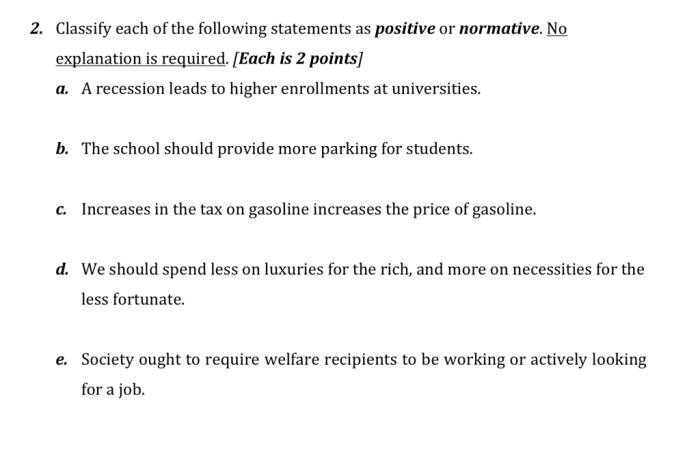Classify each of the following statements as positive or normative – Understanding the distinction between positive and normative statements is crucial for clear and effective communication. Positive statements describe facts or empirical observations, while normative statements express opinions, values, or prescriptions. This guide provides a comprehensive overview of the topic, including definitions, examples, and the significance of the distinction.
Define Normative and Positive Statements

In economics, statements can be classified into two broad categories: normative and positive. Normative statements express opinions or value judgments about what should or ought to be, while positive statements describe facts or objective conditions that can be verified through observation or empirical evidence.
Explain the distinction between normative and positive statements., Classify each of the following statements as positive or normative
Normative statements are prescriptive in nature, meaning they make recommendations or advocate for a particular course of action. They are based on the speaker’s values, beliefs, or preferences and cannot be proven or disproven using empirical evidence. Positive statements, on the other hand, are descriptive and seek to provide an objective account of the world.
They are based on facts and data and can be tested and verified through observation or experimentation.
Provide examples of each type of statement.
- Normative statement:“The government should provide healthcare for all citizens.”
- Positive statement:“The economy is growing at a rate of 2%.”
Classify Statements

Create an HTML table with four columns: Statement, Type, Justification, Example.
| Statement | Type | Justification | Example |
|---|---|---|---|
| The government should provide healthcare for all citizens. | Normative | Expresses an opinion about what should be done. | |
| The economy is growing at a rate of 2%. | Positive | Describes a fact that can be verified through data. | |
| It is wrong to steal. | Normative | Expresses a moral judgment. | |
| The unemployment rate is 5%. | Positive | Describes a fact that can be verified through data. |
Discuss the Significance of the Distinction

Explain why it is important to distinguish between normative and positive statements.
Distinguishing between normative and positive statements is crucial for several reasons. First, it helps to clarify the nature of the debate or discussion. Normative statements are often based on subjective values and beliefs, while positive statements are based on objective facts.
This distinction can help to prevent confusion and ensure that both sides of the debate are using the same criteria to support their arguments.
Second, distinguishing between normative and positive statements can help to avoid logical fallacies. For example, the “naturalistic fallacy” occurs when someone attempts to derive a normative statement from a positive statement. This fallacy is invalid because facts alone cannot justify values or moral judgments.
Provide examples of how this distinction can be applied in real-world situations.
The distinction between normative and positive statements can be applied in a variety of real-world situations. For example, in the context of public policy debates, it is important to distinguish between statements that describe the current state of affairs and statements that advocate for a particular course of action.
This distinction can help to ensure that policy decisions are based on evidence and not simply on personal preferences or values.
Another example of the importance of distinguishing between normative and positive statements can be found in the context of scientific research. Scientists strive to make objective, positive statements about the world based on empirical evidence. However, it is important to recognize that even scientific statements can be influenced by normative values and beliefs.
For example, the choice of research questions and the interpretation of data can be influenced by the researcher’s personal values and biases.
Common Queries: Classify Each Of The Following Statements As Positive Or Normative
What is the key difference between positive and normative statements?
Positive statements describe facts or observations, while normative statements express opinions or prescriptions.
Why is it important to distinguish between positive and normative statements?
This distinction helps us to identify the nature of claims, evaluate their validity, and avoid logical fallacies.
